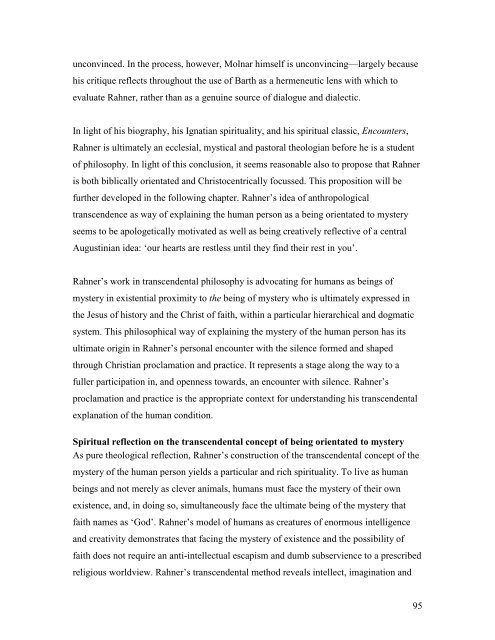Introductory notes for readers of this thesis - Theses - Flinders ...
Introductory notes for readers of this thesis - Theses - Flinders ...
Introductory notes for readers of this thesis - Theses - Flinders ...
You also want an ePaper? Increase the reach of your titles
YUMPU automatically turns print PDFs into web optimized ePapers that Google loves.
unconvinced. In the process, however, Molnar himself is unconvincing—largely becausehis critique reflects throughout the use <strong>of</strong> Barth as a hermeneutic lens with which toevaluate Rahner, rather than as a genuine source <strong>of</strong> dialogue and dialectic.In light <strong>of</strong> his biography, his Ignatian spirituality, and his spiritual classic, Encounters,Rahner is ultimately an ecclesial, mystical and pastoral theologian be<strong>for</strong>e he is a student<strong>of</strong> philosophy. In light <strong>of</strong> <strong>this</strong> conclusion, it seems reasonable also to propose that Rahneris both biblically orientated and Christocentrically focussed. This proposition will befurther developed in the following chapter. Rahner’s idea <strong>of</strong> anthropologicaltranscendence as way <strong>of</strong> explaining the human person as a being orientated to mysteryseems to be apologetically motivated as well as being creatively reflective <strong>of</strong> a centralAugustinian idea: ‘our hearts are restless until they find their rest in you’.Rahner’s work in transcendental philosophy is advocating <strong>for</strong> humans as beings <strong>of</strong>mystery in existential proximity to the being <strong>of</strong> mystery who is ultimately expressed inthe Jesus <strong>of</strong> history and the Christ <strong>of</strong> faith, within a particular hierarchical and dogmaticsystem. This philosophical way <strong>of</strong> explaining the mystery <strong>of</strong> the human person has itsultimate origin in Rahner’s personal encounter with the silence <strong>for</strong>med and shapedthrough Christian proclamation and practice. It represents a stage along the way to afuller participation in, and openness towards, an encounter with silence. Rahner’sproclamation and practice is the appropriate context <strong>for</strong> understanding his transcendentalexplanation <strong>of</strong> the human condition.Spiritual reflection on the transcendental concept <strong>of</strong> being orientated to mysteryAs pure theological reflection, Rahner’s construction <strong>of</strong> the transcendental concept <strong>of</strong> themystery <strong>of</strong> the human person yields a particular and rich spirituality. To live as humanbeings and not merely as clever animals, humans must face the mystery <strong>of</strong> their ownexistence, and, in doing so, simultaneously face the ultimate being <strong>of</strong> the mystery thatfaith names as ‘God’. Rahner’s model <strong>of</strong> humans as creatures <strong>of</strong> enormous intelligenceand creativity demonstrates that facing the mystery <strong>of</strong> existence and the possibility <strong>of</strong>faith does not require an anti-intellectual escapism and dumb subservience to a prescribedreligious worldview. Rahner’s transcendental method reveals intellect, imagination and95















